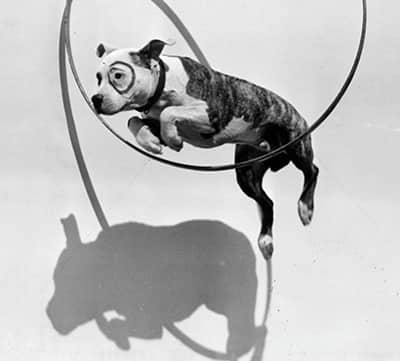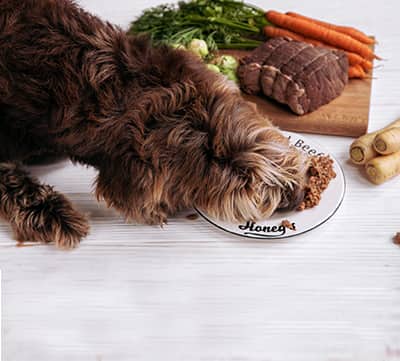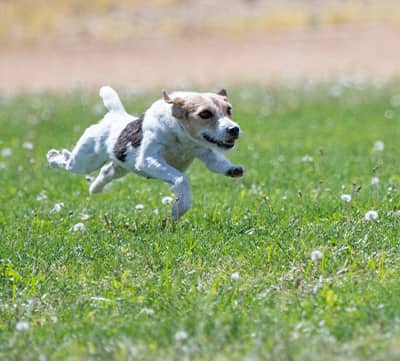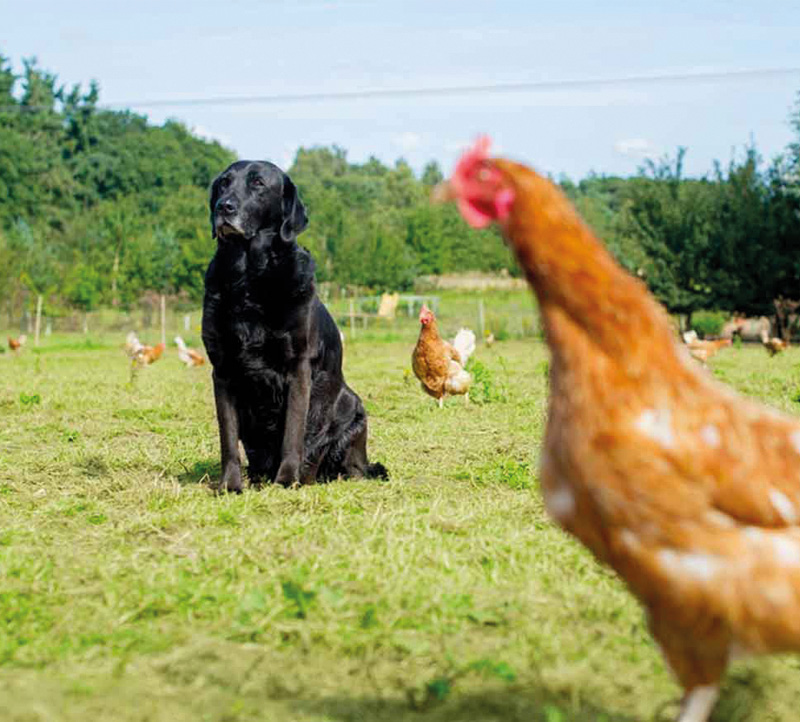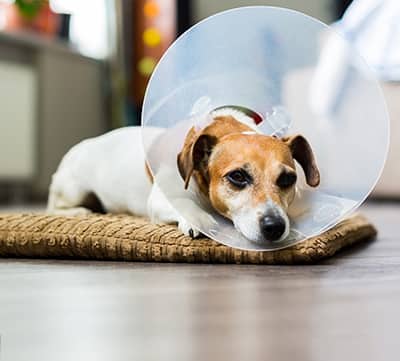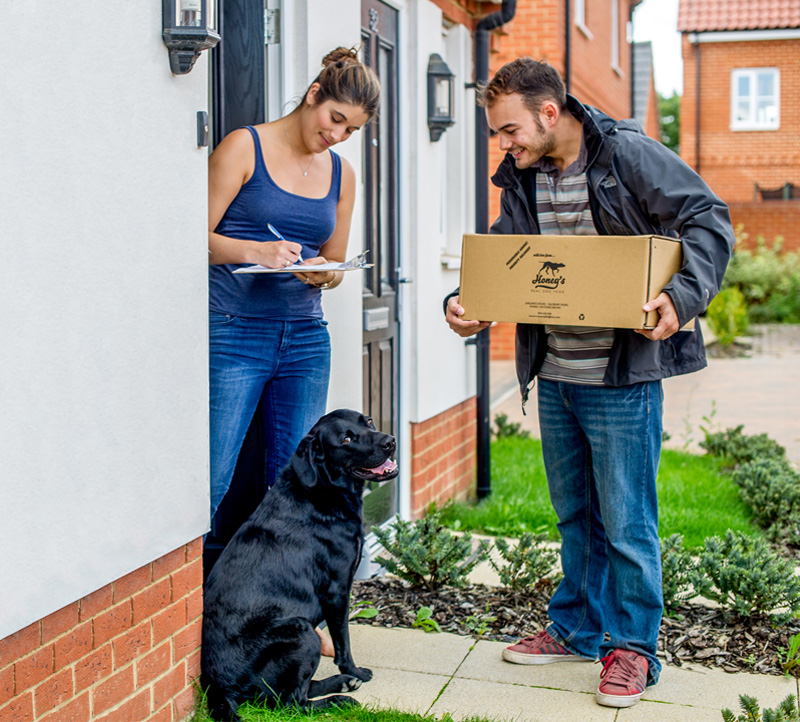The Lucky Dog Diet in detail!
In this article I explain how the Lucky Dog Diet works and provide all the information you need to transform your dog’s weight.
The benefits of the Lucky Dog Diet
The Lucky Dog Diet is everything you could want from a diet.
It is easy to prepare
To prepare the Lucky Dog Diet usually takes two or three minutes, once or twice a day.
The ingredients are easy to find
It makes use of readily obtainable ingredients. Everything you need can be found in your local supermarket and/or butcher.
Your dog will go crazy for it
Dogs love the taste and texture of the diet. You’ll be making someone (with four paws) very happy!
It is approved by vets
The Lucky Dog Diet has been checked and approved by a number of vets as being safe and effective.
It is easy to understand
There’s nothing complicated about the Lucky Dog Diet. Even the science is easy to understand.
You can expect rapid results
Usually you will see a dramatic difference in just 14 days (this is especially true of dogs coming off kibble). We know it is not as if your dog has to get into special clothes (such as a bikini or a morning suit) by a specific date, but still, it is nice to know that it isn’t going to take months and months and months to see the improvement.
Your dog will lose the right sort of weight
One of the best things about the Lucky Dog Diet is that it leads to the loss of excess fat and not muscle mass.
Extra exercise is good but not vital
Although I strongly recommend extra exercise to speed things up and generally improve your dog’s health, it isn’t vital to the plan.
It will really improve your dog’s health
In addition to the health benefits associated with being the correct weight, there are all sorts of other health benefits associated with this diet. Indeed, if you continue the diet after your dog’s target weight has been achieved you can expect him or her to live a longer, healthier life.
Backed by research
The Lucky Dog Diet is simplicity itself: a natural diet that is high in protein, low in carbohydrates and contains the optimum level of ‘healthy’ fat together with an appropriate exercise regime.
Extensive research has been done into the principles underlying the Lucky Dog Diet. Most notably in 2002, a team of scientists published a paper entitled Weight Loss in Obese Dogs: Evaluation of a High-Protein, Low-Carbohydrate Diet. Their findings were conclusive: there just isn’t a better way for a dog to lose weight.
How much should your dog weigh?
The first step when introducing the Lucky Dog Diet is to work out your dog’s ideal weight. What you should be aiming for is ‘lean’. That is to say:
- You should be able to feel your dog’s ribs when you touch your fingers gently to the rib cage.
- From the side the belly should be tucked up.
- From above your dog should have a proper waist.
The diagram explains this better than words, of course. You will note that the experts believe dogs should have a body condition score of 4.5 or 5 out of 9.

There’s no magic formula for working out how many pounds or kilos your dog should be losing. Although it is easy to weigh your dog yourself, there is something to be said for getting your vet to do it for you and asking, at the same time, for a target. Another benefit of involving your vet is to check that there are no underlying health issues.
Incidentally, a study by a major dog food manufacturer has shown that a dog’s life expectancy is significantly improved by being the correct weight.
Timing
The beauty of the Lucky Dog Diet is that it isn’t really time critical. That is to say, there is no need for you to set yourself the objective of slimming your dog down by a specific amount within a set period. My own experience is that an overweight dog will reach target weight in two to six weeks, whereas an obese dog may require up to 12 weeks (or more) to get into shape. I’d urge you not to rush it.
The role of exercise
There is absolutely no doubt that exercise plays a key role in weight loss. It is possible for your dog to reach his or her target weight without increasing the amount of exercise taken, but it will slow the whole process down. Moreover, exercise brings with it huge health benefits.
The diet!
The perfect diet for your dog uses raw ingredients and is high in natural protein, low in carbohydrates and contains the optimum level of ‘healthy’ fat. What does this mean in practice? You will be feeding your dog ingredients from four different groups:
Group 1: Raw, lean muscle meat and organs
Group 2: Raw, meaty bones
Group 3: Raw vegetables and fruit
Group 4: ‘Boosters’ such as eggs, sardines &c.
How much of each? Approximately one-third raw meat, one-third raw bones and one-third raw vegetables and fruit. Approximately? Yes! The percentages don’t have to be 100% accurate every day, providing you balance things out over a period of a week or two. In the wild dogs eat what is available and receive the nutrition they need over time. They most definitely don’t carry scales and calorie counters around with them.
What about the ‘boosters’ mentioned above? These are to give your dog extra nutrition and vitamins and you simply add one item every other day.
Let me just spell it out again:
- Your dog’s diet will consist almost entirely of raw meat, raw bone and raw vegetables/fruit. This is a dog’s biologically appropriate diet (think wolf!) and they thrive on it.
- Every meal should consist of roughly 1/3rd raw meat, 1/3rd raw bone and 1/3rd raw vegetables/fruit.
- The proportions are important but you don’t have to be obsessive about it.
- You can pick more than one ingredient from each group each day although it is better not to mix protein sources. In other words, serve chicken meat with chicken bones and beef meat with beef bones. However, a bit of mixing and matching is fine if it is easier.
- You’ll also be feeding a ‘booster’ ingredient every other day.
Lists of ingredients (designed to make it easy for you to shop) and sample menus are to be found below.
Stick to less fatty meats
Although your dog needs a certain level of ‘good’ fat in his or her diet it is important not to overdo it. For this reason, I strongly advise you to avoid fatty meats (such as lamb) and fatty cuts (such as beef with marbling in it).
How much to serve
Another wonderful feature of the Lucky Dog Diet is that you don’t have to concern yourself with the number of calories in the food you are serving. Instead you simply have to weigh all the food. Initially, I advise anyone new to the Lucky Dog Diet to start by feeding his or her dog 1.5% of its body weight each day (unless it is a miniature or small dog, in which case see below).
Let me give you an example:
Rex weighs 30 kg.
Every day he gets 1.5% of his weight in food.
1.5% of 30kg is 450g.
Every day Rex gets 450g of food.
The 450g of food should, of course, consist (more or less) of 1/3rd, 1/3rd, 1/3rd meat (including offal), bone and vegetable/fruit. So 150g raw meat, 150g raw bone and 150g vegetables/fruit. You can feed it all in one go but I prefer to feed it in two lots as this means the dog will burn up more calories.
Should I stick to 1.5%?
I suggested you begin by feeding 1.5% of your dog’s body weight every day but if, after a week or two, you are seeing no appreciable loss in weight then you may need to drop the amount to 1%. Miniature, toy and small breeds need more food! Even when they are on a diet miniature, toy and small breeds usually need more than 1.5% of their bodyweight a day. Below are my recommendations. If, after a week or two, you are seeing no appreciable difference in weight then you may need to drop the amount down gradually until you find a level at which your dog is starting to lose those unwanted pounds.
1–2kg 7%
3–4kg 5%
5–8kg 3%
9–10kg 2%
I must stress it is always hard to apply hard and fast rules for the smaller dogs. In reality, breeds such as Shih Tzu, Lhasa Apso, Maltese and Bolognese tend to be much more sedentary, so often don’t need anything like as much as the normal percentage, even for maintenance, whereas Chihuahuas, Pomeranians, Papillons and Yorkies tend to be more active and ping around all over the place and so burn off food at a much higher rate.
How to weigh your dog (and how often to do it)
Wriggly things, dogs, and they are not always willing to step neatly onto the scales to be weighed. The solution, if you are having a problem weighing them, is to weigh yourself holding your dog and then again not holding your dog. My arithmetic is useless but even I am pretty certain that the difference will represent the weight of your dog.
Mrs. Smith holding Twiggy in her arms93kg
Mrs. Smith all by herself60kg
Twiggy33kg
Ideally, you should weigh your dog once a week and then adjust the daily portion size accordingly, keeping it at a steady 1.5% (or whatever percentage you have decided upon).
No special equipment needed
You won’t need any special equipment, just a set of kitchen scales, a blender or food processor, a cutting board and knife and a weighing scale (for humans).
Preparing the food
The Lucky Dog Diet requires almost no preparation. Here are some tips:
- When you are serving meat you may like to mince it (if it isn’t minced already) or cut it into cubes.
- Dogs are remarkably clever at dealing with carcasses, chicken wings, meaty bones and so forth… it is the most natural food in the world for them.
- The vegetables and fruit can be put through the food mixer and either juiced or grated.
- When you are serving bones just make sure that they are too large to gulp down in a single bite.
Dogs gulp their food because they can’t chew and because there are no digestive enzymes in their saliva. So, you shouldn’t worry about this. A small number of dogs, maybe about one in a hundred, find the switch to raw food a little confusing and they are not quite sure what to do.
INGREDIENTS FOR YOUR LUCKY DOG
Variety is the spice of life. It is important that your dog receives his or her nutrition from lots of different sources. Use meat from different animals. Use different parts of the animal. Use seasonal vegetables. Here are the four ingredients that make up the Lucky Dog Diet.
Group 1: Raw, lean muscle meat and organs
Raw, lean muscle meat and organs should make up 1/3rd of your dog’s daily food. You’ll notice that marrow bones and knuckle ends are included in this group. Why? Because the marrow in the middle of the bone is brim full of (healthy) but high calorie fats.
On your shopping list:
- Beef heart (aka ox)
- Ox tongue
- Tripe
- Lean minced or cubed chicken
- Chicken hearts
- Turkey heart
- Lamb heart
- Lean minced or cubed turkey
- Lean minced or cubed goose
- Lean minced or cubed pork
- Venison meat
- Venison heart
- Lean minced or cubed duck
- Pork tongue
- Beef marrow bones (the knuckle ends are best)
You’ll notice that I have left off two easy to obtain ingredients from this list: lamb mince and beef mince. The trouble with any mince is that it tends to have a high proportion of fat in it and this is especially true of lamb and beef. If, however, you can obtain really, really lean lamb or beef it is fine to use it.
What about carcasses and wings?
Chicken, duck and turkey carcasses (aka ‘backs’, as in chicken backs) as well as wings can replace both the meat and bone element of the diet depending on how meaty they are. If you can get carcasses/wings then you could feed them as often as three times a week. Unless your dog loves vegetables, you can just forget about the vegetable element on those days.
On your shopping list
- Chicken carcasses
- Chicken wings (remove the skin)
- Turkey carcasses
- Turkey wings (remove the skin)
- Duck carcasses (remove the skin)
- Duck wings (remove the skin)
- Whole rabbits gutted, feet removed, beheaded and skinned
- Whole pheasant and other game
- Goose carcasses (remove the skin)
Group 2: Raw meaty bones
Raw, meaty bones should make up 1/3rd of your dog’s daily food. The important point is that they must be raw (raw bones are surprisingly soft and dogs have such strong stomach acids they can readily digest them). In the wild up to a third of a dog’s nutrition (including calcium, magnesium, complex fats and vitamins) may come from bones. Bones keep their teeth and gums clean (it has been proven that dogs with healthy teeth live longer) and exercise their upper body and jaw. Providing the bones are raw (cooked bones can splinter), they are 100% safe for dogs to eat.
On your shopping list
- Pork ribs
- Pork trotters
- Venison ribs
- Venison neck
- Chicken necks
- Turkey necks
- Duck necks
- Lamb ribs
- Lamb neck
- Lamb trachea
- Beef trachea
Group 3: Raw vegetables and fruit
Vegetables and fruit should make up 1/3rd of your dog’s daily food. It is vital that the ingredients are fresh. Tired-looking vegetables and fruit have lost most of their nutritional value. Whether you include one item from this list every day or several doesn’t really matter. Unless your dog loves eating vegetables (some do) my advice is to either blend or juice the ingredients and to then mix it in with the other ingredients. Vegetables and fruit are a dog’s best protection against cancer. The fruit element should never be more than a small percentage of the vegetable/fruit you serve – say no more than about 10 to 20%.
Shopping list
- Broccoli
- Celery
- Celeriac (go easy as it has a high sugar content)
- Chinese cabbage
- Courgette
- Beetroots (go easy as they have a high sugar content)
- Carrots (go easy as they have a high sugar content)
- Parsnips
- Cauliflower
- Spinach
- Kale
- Green leafy vegetables
- Butternut squash
- Pumpkin
- Peppers (red, yellow and orange but not green)
- Mangetout
- Blueberries
- Blackberries
- Raspberries
- Strawberries
- Red watermelon
- Apples (go easy as they have a high sugar content)
- Pears (go easy as they have a high sugar content)
- Bananas (just a small piece and not too often)
- Pineapples (go easy as they have a high sugar content)
Starchy vegetables to avoid: peas, potatoes, sweet potatoes, onion and leek. Fruit to avoid: grapes, avocado, dried fruit
Group 4: ‘Boosters’ such as eggs, sardines &c.
Choose ONE item from this list and add it every other day. In plain English on a Monday you could add an egg, on Tuesday nothing, on Wednesday a few tinned sardines, on Thursday nothing and on Friday a teaspoon of chia seeds. These ‘boosters’ are not vital to the diet but help to ensure that your dog receives a wide range of nutrients.
Shopping list
Eggs
One egg for a small or medium sized dog. Two eggs for a very large dog. Eggs are packed full of protein and valuable nutrients, essential fats and vitamins. Include shells.
Sardines in water with no salt added
Add one sardine for a small dog, three for a medium sized dog and a whole tin for a large dog. Sardines are a great source of protein, trace minerals and vitamins.
Hempseed oil
One teaspoon. Contains valuable essential fatty acids/Omegas.
Flaxseed oil
One teaspoon. Contains valuable Omegas.
Chia seeds
One teaspoon. Contains valuable amino acids, fibres and minerals. Good source of Omegas, too.
Live yoghurt
One tablespoon for every 10kg your dog weighs. Good probiotic.
Sample menus
Just to recap. You are feeding your dog 1.5% of its body weight every day (unless there is a reason to vary this amount). The food you serve will consist of 1/3rd meat, 1/3rd bone and 1/3rd vegetable/fruit taken from each of the groups above.
It is better not to mix sources (i.e. serve chicken with chicken). You are weighing your dog once a week and will adjust the quantities as necessary.
Below is a sample menu for a week. You’ll notice that on a couple of days I have suggested skipping either the bone or the vegetables. The beauty of the Lucky Dog Diet is that you don’t have to follow the rules religiously. There’s a bit of flexibility.
| Group 1: Raw, lean muscle meat and organs | Group 2: Raw meaty bones | Group 3: Raw vegetables and fruit | Group 4: ‘Boosters’ every other day | |
| Sunday | Minced chicken | Chicken carcass with no meat on it | Cabbage, broccolli and apple | Egg |
| Monday | Cubed pork | Pork ribs | Carrot and cauliflower | |
| Tuesday | Minced duck | Duck neck | Spinach, mangetout and banana | Sardine |
| Wednesday | Beef knuckle bone | No need for extra bone | Skip for a day | |
| Thursday | Ox heart | Skip for a day | Pumpkin, celery and blueberries | Hempseed oil |
| Friday | Duck back and wings | No need for extra bone | Kale and red pepper | |
| Saturday | Whole rabbit | No need for extra bone | Skip for a day | Live yoghurt |
A few words about treats
A treat is not food. Its purpose is either to reward a dog or, of course, to spoil them! Dogs love receiving treats and we love dispensing them. Of course, a treat is only a treat if the recipient likes it. There are few dogs, for instance, that consider a spinach leaf to be a treat! On the other hand, dogs (like humans) can be trained to enjoy new tastes and sensations. For example, dogs can be trained to view a piece of cut-up apple or carrot as something highly desirable.
Here are a few treat tips:
- Size isn’t necessarily important when it comes to treats. A tiny, tiny little piece of something desirable (for instance a piece of cooked chicken quarter the size of a sugar lump) will be well received.
- Little bits of cut-up carrot make an excellent treat. If your dog is dubious try cooking them slightly, rubbing them on some meat or adding a few drops of real gravy to give them extra taste. Remember, carrot has a high sugar content, so go easy in terms of quantity.
- Break larger treats into smaller pieces and use more sparingly.
- Air-dried treats (such as air-dried liver) are high in protein but low in fat.
- Avoid rawhide (high in fat) and jerky type (potentially contaminated) treats.
- Apple makes a great treat. Take the same approach as you would with carrot.
- Blueberries (packed full of valuable antioxidants) are easy to carry around and can also be popular.
An Oscar for Oscar
Your dog may believe, and may even convince you, that he or she is starving to death from lack of food. Don’t be fooled. Dogs are incredibly talented actors. In fact, because the Lucky Dog Diet has high quantities of protein and healthy volumes of ‘good’ fats your dog shouldn’t actually feel hungry. A good option, when a dog is making those food eyes at you, is to distract him or her with a game or a cuddle. If you feel you simply must do something then increase the volume of fibrous vegetables in the food. Only, be warned: fibrous vegetables can have two side effects: larger volumes of, ahem, waste matter and a greater tendency to, ahem, wind.
Vicky Marshall
Author of the Lucky Dog Weight Loss Plan
For more information and advice on any aspect of canine health and nutrition please contact Honey’s – we’ll be happy to help even if you never, ever plan to become a customer.
Web: www.honeysrealdogfood.com
Email: info@honeysrealdogfood.com
Telephone: 01672 620 260
